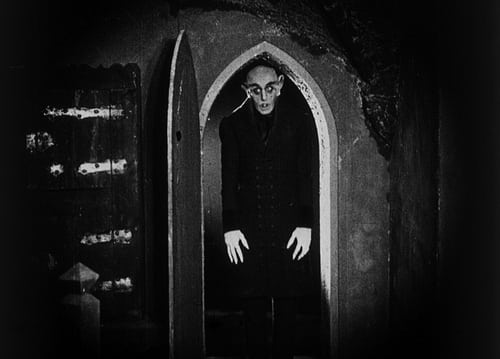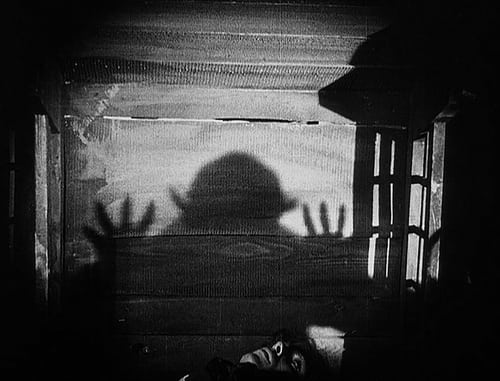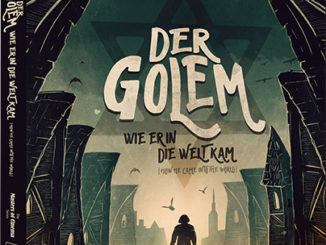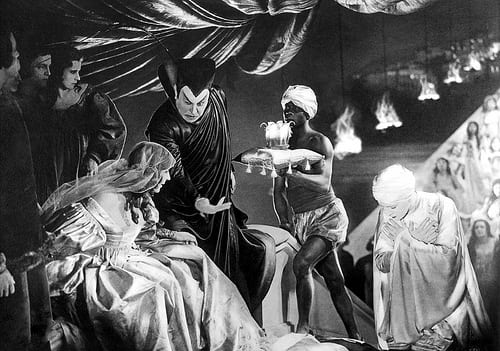Nosferatu (1922)
Directed by: F.W. Murnau
Written by: Henrik Galeen
Starring: Alexander Granach, Greta Schroeder, Gustav von Wangenheim, Max Schreck
HCF REWIND NO. 159 : NOSFERATU AKA NOSFERATU: EINE SYMPHONIE DES GRAUENS, NOSFERATU: A SYMPHONY OF HORRORS [Germany, 1922]
IN SELECTED CINEMAS: 25th October
RUNNING TIME: 100 min
REVIEWED BY: Dr Lenera, Official HCF Critic
Estate agent Thomas Hutter is sent from his German home in Wisborg to Transylvania to visit a new client named Count Orlok. Nearing his destination in the Carpathian mountains, Hutter stops at an inn for dinner where the locals become frightened by the mere mention of Orlok’s name and discourage him from travelling to his castle at night, warning of a werewolf on the prowl. His coachman declines to take him any further than a bridge, but a black-swathed coach appears to take Hutter the rest of the way. At the castle, Count Orlok, tries to suck the blood out when Hutter cuts his thumb. Hutter wakes up to a deserted castle the morning after and notices punctures on his neck, which he attributes to mosquitoes or spiders. That night, Orlok signs the documents to purchase the house across from Hutter’s own home. Reading a book about vampires that he took from the local inn, Hutter starts to suspect that Orlok is Nosferatu, the ‘Bird of Death’….
F.W.Murnau’s Nosferatu is often regarded as the greatest of all vampire films, and has even appeared on quite a few ‘best film’ lists like Sight & Sound’s Critic’s Poll of the hundred greatest films in world cinema. Countless films have taken scenes and shots from it, from the 1931 Dracula [I don’t think enough has been written about how much it borrows from Nosferatu, with certain scenes, like one set in a inn, almost exactly the same] all the way to the 1992 Dracula, while it has been an inspiration for countless more. It laid the ground roots for the modern vampire legend even more than Bram Stoker’s novel Dracula, a good example being the issue of daylight. In Dracula, the title character can walk about perfectly fine during the day, only that his powers are diminished. In Nosferatu, sunlight can kill him [though if you watched one of the many inferior prints of the film you could be confused by the day-for-night footage of him and think it was meant to be during the day!]. What is also interesting is what has not been used much from Nosferatu, in particular the portrayal of Dracula himself. Starting right from Bela Lugosi, the Count became an attractive and even sexy figure, and this was taken further later, but Orlok is thoroughly loathsome and repulsive, and this, ignoring the 1979 remake, was rarely repeated, though the make-up, with claw-like nails, fangs that are in the middle of his mouth like a rat’s, and bat ears, did turn up in the 1979 version of Salem’s Lot and was virtually recreated in The Descent.
Historically then, and I must add that the film also perfected certain cinematic techniques such as montage and virtually introduced others like matched action cuts, Nosferatu is immensely important. Now this writer is going to be controversial and state a slight preference for Werner Herzog’s remake over this film, but that is not to denigrate the 1922 picture: it’s just a matter of personal enjoyment more than anything else. It goes without saying that Nosferatu should be seen by any horror fan, and actually has been an instance of a silent film that, since the advent of home viewing, has always been in circulation in differing versions, but is it enjoyable? Well, it certainly needs to be viewed in the right environment, probably at midnight with all the lights off. Then, the film’s nightmarish feel can come to the fore and seep into the viewer. By today’s standards you probably can’t call it scary, but if you are tiring of gore and jump scares, you may the find the more subtle chill of Nosferatu very pleasing and still rather effective. Watching Eureka’s fabulous restoration last night, it occurred to me, far more than before, that I was almost virtually watching the vampire, and even the horror, genre being invented before my eyes. And it must have absolutely terrified audiences of the time who hadn’t seen anything like it, even if German Expressionism had already produced striking work like The Cabinet Of Dr.Caligari and The Golem.
Nosferatu was the only production of Prana Film, founded in 1921 by Enrico Dieckmann and Albin Grau. Grau was inspired by make a vampire film by an experience he had whilst serving in World War 1, where a Serbian farmer told him that his father was a vampire and one of the undead. Now it has been debated whether Nosferatu actually was the first Dracula film: many sources that the Hungarian picture Drakula halala [The Death of Dracula] got there first, though that film, which is lost, doesn’t appear to be an actual adaptation of Stoker’s book. Now the producers of Nosferatu didn’t buy the rights to the book and changed the names of the characters to try to get away with it, but there was no doubt that, despite the removing of some characters and a new ending, here were the first two thirds of the novel. The Stoker Estate sued Prana and as a result the film was removed from circulation, though some prints survived. They were usually of poor quality and often heavily cut [I once saw one that only ran for an hour, and this ‘cut-to-the-bone’ Nosferatu actually wasn’t bad], while the loss of the original score meant that several different musical soundtracks accompanied the film, my favourite being the one by Hammer composer James Bernard. Eventually the Murnau Estate embarked on a huge restoration for the film and not only pieced together the complete film but found the original intertitles and score, which was re-recorded. This version is the one Eureka present here.
The film takes its time for a while, not letting us see Orlok for half an hour, but there is a strong sense of foreboding, whether it be the scenes with Hutter’s creepy employer Knock [the Renfield character] who looks a bit like a ‘nosferatu’ himself, or certain detail like Hutter giving his wife Ellen some flowers which immediately die. Eventually we arrive at Nosferatu’s castle, and for the outside shots they used a real dilapidated castle in Slovakia. The interior isn’t quite as sinister as Lugosi’s, but Orlok is genuinely freaky from the moment he appears, walking stiffly like a corpse towards the camera [well, that’s not entirely true, we’ve already seen him disguised as a coachman!] in a most unnerving manner. Rumours abounded, perpetuated by the director [proving hype has always gone hand in hand with the cinema], that actor Max Schreck [his name translates as ‘Maximum Terror’!], who never appeared out of character or without makeup, was an actual vampire, and you can almost believe it watching him. Like Hammer with Christopher Lee, Orlok’s appearances are short and few in number, but used for great impact. In one great shot which must have had 1922 viewers climbing the walls, he suddenly rises out of his coffin while keeping his feet on the ground. It is an earlier scene which is probably more impressive though, as Murnau intercuts Orlok approaching the terrified Hutter with Ellen sleepwalking and reaching out her arms towards….something….maybe Orlok. The editing and narrative patterning tieing the two events together was very advanced for its time, and, along with some really odd experimental bits like speeded up motion when Orlok is building his coffin, must have confused as many cinema-goers as scared them!
The story proceeds much like the novel, with Orlok taking over a ship heading for the town where Ellen lives and purchasing a house opposite hers, except that this vampire doesn’t create other vampires, he just feeds, and it is the plague [and rats!] that he brings to Wisborg with him that ends up virtually decimating the town. And finally we get the astounding climax that had been copied a million times and never matched, as Orlok goes to feed on Ellen, his misshapen shadow on the wall resembling the Devil and the shadow of his arm moving up from between her legs in a striking image of rape and carnal fear which is more powerful than a hundred graphic of sexual assault. Despite his hideousness, this vampire still has a strong sexual aspect to him, only it’s a thoroughly repulsive one. One of the main attraction of the vampire legend is that it somehow makes attractive and even romanticises things like necrophilia and sadomasochism. Nosferatu still has those hinted at, but a totally repugnant, fearful way. It also has very little of the religious imagery and themes that one associates with Dracula.
Henrik Galeen’s script is sometimes awkward and contains a few scenes which don’t seem necessary, but Murnau fills the film with devices which enhance the feel of a Gothic dream world, from characters emerging from shadows to spider webs all over the place, yet his use of real locations and authentic looking extras somehow give it an almost believable feel too. I say almost, because of course much of the acting is extremely over-the-top to modern eyes. Gustav Won Wangenheim, as Hutter, is especially given to exaggerating every little gesture, but this is how acting was in those days, especially in German Expressionism. More difficult, perhaps, is the Hans Erdmann score, which is often oppressively heavy and certainly wasn’t too easy on this critic’s ears. It’s fantastic that we can see and hear Nosferatu pretty much as it originally was, but it might be preferable to some to turn the sound down when this version comes onto DVD and Blu-ray. This is something actually that I often do with silent films, especially those accompanied by music which doesn’t seem to go with the images very well. In any case, Nosferatu has a primal quality that will stick with you far longer than most modern horror films which may be initially terrifying but are soon forgotten and diminish with successive viewings. Nosferatu will never diminish, because it seems to get closer than most other films to the roots of why we love the dark, why we love its phantoms, and why we love being made to feel emotions that any sane person ought to find stupid.
Rating: 









As well as its cinema release, Nosferatu also features as part of the BFI’s Gothic: The Dark Heart Of Film which runs from 21st October to 31st January 2014 and celebrates the Gothic in film and TV with over 150 titles being shown and around 100 screenings. The 1979 Nosferatu The Vampyre is also amongst the films being shown, and will also be released to selected cinemas on 1st November. For more details, check out www.bfi.org.uk/gothic
Nosferatu will be re-released by Eureka with brand-new extras on DVD, Blu-ray and Blu-ray Steelbook in the near future
And look out for my reviews of Shadow Of The Vampire [about the making of Nosferatu] and Nosferatu The Vampyre soon!








Be the first to comment